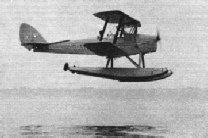The Seaplane Club can trace its origin back to the early 1960's. A group of pilots bemoaned the lack of seaplane flying in Great Britain, given its rich history of water flying reaching back before the First World War. To rectify this situation, they formed the "Seaplane Club of Great Britain".
It attracted some eminent patrons in the form of Baron (Sholto) Douglas of Kirtleside as President, Short Brothers directors John Lankester Parker (Chairman) and Oswald Short. All these gentlemen were experienced seaplane pilots, indeed J. L. Parker was Chief Test Pilot for Shorts.
With such impeccable credentials, it was possible to attract enough funds to purchase
the Club's first aircraft. This capital expenditure was rendered unnecessary as a
Tiger Moth aircraft (G-
However (as anyone who has been involved with water flying will know) this was just one of the many obstacles that needed to be overcome. The first major action item was to find somewhere to base the floatplane. Various venues were considered along with the interminable discussions with every organisation that might think it should have an interest in such a venture.
Some of the more weird requirements were that the seaplane must be able to go astern and also be covered by the same safety and handling rules as a live bomb!!
Finally, Lee-
Meanwhile the Club still needed to convert the Tiger Moth onto floats, so it could be used more than once. Both the Canadian and English De Havilland companies found enough details within their archives to allow the Club's Chief Engineer to create a suitable design of struts to support the Moth on its floats. These were originally fitted to an Aeronca Sedan aircraft.
Finally that progressive government department, the aforementioned Ministry of Aviation,
granted special dispensation for pilots to fly the new floatplane on their licences,
due to the lack of current seaplane pilots in the country. Happy Days -

History

Copyright of The Seaplane Club -
First Flight of G-